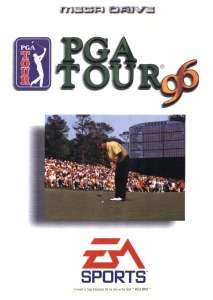PGA Tour 96
| PGA Tour 96 | |
|---|---|
 | |
| Developer(s) | Hitmen Productions |
| Publisher(s) | Electronic Arts |
| Series | PGA Tour |
| Platform(s) | PlayStation, Game Boy, Sega Genesis, 3DO, Sega Game Gear, SNES |
| Release |
PlayStationGame BoySega Genesis3DO
|
| Genre(s) | Traditional golf simulation |
| Mode(s) | Single-player, multiplayer |
PGA Tour 96 is a 1995 sports video game originally released for PlayStation and then ported on Game Boy, Sega Genesis, 3DO, Sega Game Gear and SNES.
Gameplay
It has fewer courses and golfers than previous installments. The game features 10 professional golfers as playable or as CPU opponents: Brad Faxon, Lee Janzen, Tom Kite, Bruce Lietzke, Davis Love III, Mark O’Meara, Peter Jacobsen, Jeff Sluman, Craig Stadler, and Fuzzy Zoeller. The featured courses are Spyglass Hill, TPC at Sawgrass, TPC at River Highlands. The game has four modes: stroke play, match play, tournament mode, and practice mode. Golf clubs are assigned automatically by the caddy as the computer deems suitable for every lie and every situation.
Reception
| Reception | ||||||||||
|---|---|---|---|---|---|---|---|---|---|---|
| ||||||||||
Electronic Gaming Monthly's two sports reviewers gave the PlayStation version scores of 8.5 and 9.0 out of 10, remarking that it retained the excellent aspects of previous games in the series while dramatically improving on the graphics. They also felt that it successfully appealed to both novices and golfing pros.[1] GamePro criticized it for having only two courses but highly praised the precise level of control over each shot, selection of players, three dimensional terrain, and digitized sprites. They concluded that "With spectacular graphics and amazingly comprehensive controls, PGA Tour '96 immerses you in intense armchair golf."[6] In contrast, Maximum called it "the weakest of the series yet". While they too approved of the ability to control every aspect of each shot, they felt that the game was ruined by the unrealistic ball physics, particularly that balls stop dead with almost no rolling when they hit the ground, and that putted balls stop suddenly instead of gradually slowing.[2] Next Generation approved of the game for its easy interface and numerous play options, though unlike GamePro and EGM they found the graphics to be "a little on the underwhelming side" by the standards of current generation consoles.[3]
Reviewing the 3DO version, Johnny Ballgame of GamePro commented, "If you thought golf was boring, think again." He was pleased with the selection of modes, accurate controls, and sound, and said that the graphics, though slightly grainier than in the PlayStation version, are stunningly lifelike in absolute terms.[7] A reviewer for Next Generation found the game was an effective "jump in and play" experience, but lacked the realism and level of content that serious golfers would expect from a golf video game.[5]
Air Hendrix of GamePro remarked, "EA Sports tried to cram its marvelous PlayStation PGA game into a Genesis cart, and it just didn't fit." In addition to the inferior graphics and slow screen redrawing, he criticized the absence of the shot-planning features seen in the PlayStation version and previous iterations on the Genesis, saying this makes it impossible to precisely calculate one's shots.[8] He gave the SNES version a lukewarm review, saying it fails to outdo the Genesis's PGA Tour Golf III, due to the weak audio and absence of features like backspin and 3D terrain, but is superior to the Genesis version of the game and makes an overall "good round of golf". He praised the detailed backgrounds and fluid movements.[9] GamePro's Scary Larry praised the Game Boy version as offering good options, graphics, sounds, and most importantly, an appealing "plug-and-play" style. He was less pleased with the Game Gear version, saying that the graphics and presentation enhancements serve mainly to slow the game down with heavy screen redraw.[10]
Next Generation reviewed the Genesis version of the game, and stated that "if you haven't sampled any of the PGA series, it is still the best golf game available for the 16-bit machines and a fine addition to your library."[4]
References
- 1 2 "Box Score: PGA Tour '96". Electronic Gaming Monthly. No. 76. Sendai Publishing. November 1995. p. 248.
- 1 2 "Maximum Reviews: PGA Tour '96". Maximum: The Video Game Magazine. No. 3. Emap International Limited. 1996. p. 152.
- 1 2 "PGA Tour Invitational '96". Next Generation. No. 12. Imagine Media. December 1995. pp. 176–7.
- 1 2 "Finals". Next Generation. No. 12. Imagine Media. December 1995. p. 198.
- 1 2 "PGA Tour Golf '96". Next Generation. No. 14. Imagine Media. February 1996. pp. 167–8.
- ↑ "PGA '96 Revolutionizes Golf". GamePro. No. 86. IDG. November 1995. p. 106.
- ↑ "PGA Tour '96". GamePro. No. 90. IDG. March 1996. p. 78.
- ↑ "PGA Tour '96 Bogies on the Genesis". GamePro. No. 87. IDG. December 1995. p. 122.
- ↑ "PGA Tour '96". GamePro. No. 91. IDG. April 1996. p. 93.
- ↑ "PGA Tour '96". GamePro. No. 88. IDG. January 1996. p. 120.